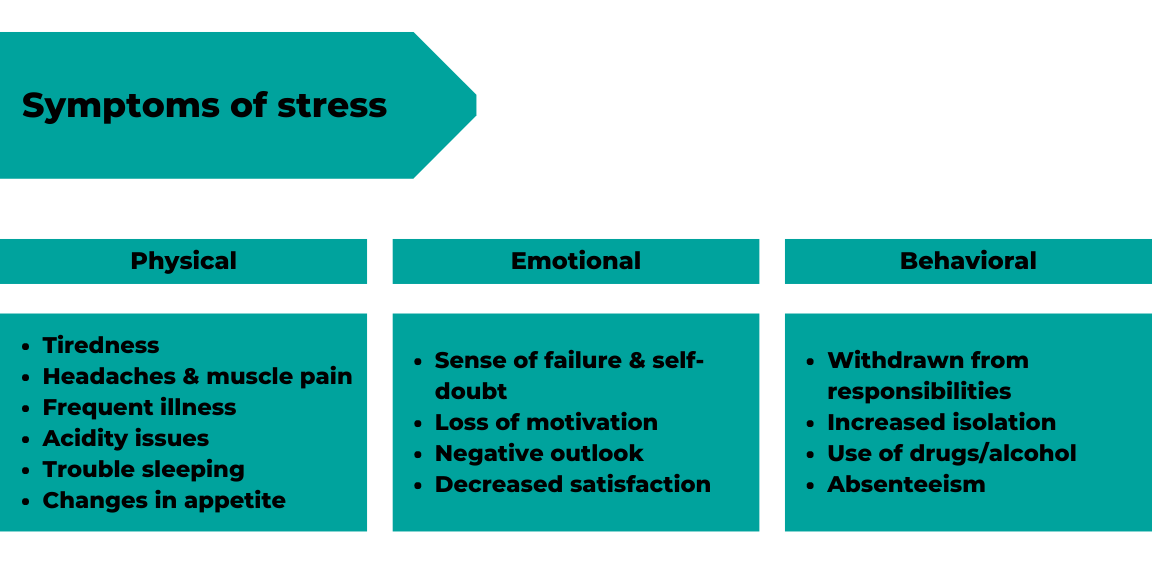
Causes of Stress in Organizational Behavior - How to Manage Them?
Stress in an organization is very common. Employees as well as organization leaders often feel stressed due to several reasons. Too much stress is harmful to the organization. If more employees become stressed out, their ability to work efficiently reduces. Absenteeism and employee turnover increase. The employees as well as the company, both suffer. Stress management in the workplace is therefore extremely important! But first, a very crucial step in managing stress is to understand the symptoms and causes of stress in organizational behaviour.Symptoms of Stress
Symptoms of stress can be classified into three categories; physical symptoms, emotional symptoms and behavioral symptoms.
Causes of Stress in Organizational Behaviour
Stress can be caused by a variety of factors. Knowing these factors well will allow you to manage them and build a better working environment for your employees. The following are the main causes of stress in organizational behaviour and tips on how to manage them.
Concern Regarding Career
Employees might feel concerned about not growing in their careers due to fewer growth opportunities or feel stuck in the same position for too long.
How to Resolve?Reward your employees for their efforts. Offer promotions and salary appraisals when deserved. If your employees feel appreciated, it will reduce their stress levels and make them feel they are achieving a positive outcome working in the organization. Give them opportunities to learn and grow in skills. Provide them exposure. You can sponsor learning courses for them as well.
Uncertainty of Roles/Responsibilities
If employees feel uncertain or unsure about what is expected of them, and what is exactly their daily responsibilities, they might feel confused and gain stressed.
How to Resolve?Develop clear communication with your employees. Talk to them more often. Map out their responsibilities clearly and regularly have a meeting regarding them. Let them know what you are expecting and how much time you are expecting it. Just having an open discussion and letting them know you are available for questions can fix this problem.
Rotating & Extra Long Shifts
Extra long shifts leave no room for personal time and may even tire the employee to exhaustion.
How to Resolve?Have balanced shifts. If there is a requirement for your employee to work extra shifts, offer them smaller shifts or paid half-day leaves for later. Make sure they get their rest so they can come back stronger. Rotating shifts should be avoided if the employee isn’t comfortable with them. If rotating shifts cannot be avoided offer them a chance to work from home during some of them. Once again communication is the key. Let them convey to you what brings the most productivity in them.
Unexpected Sudden Changes
Too many changes that happen quite often leave an employee feeling unstable and adjusting most of the time.
How to Resolve?
Follow a smooth transitioning process when it comes to changes. For example, if you are changing your employee's roles maybe because he or she got a promotion, offer them as much help as possible and also give less workload in the beginning. If you are bringing a new team manager or client to work with, have them introduced, talk and get to know each other. If you are making new policies, give prior notice to employees and give them time to adjust. Before making any changes in the offices and cubicles, talk to the employees first.
Workload
No one can handle over workload well. Burdening your employee with extra work, making them work extra hours or providing unjustifiable deadlines are some of the obvious reasons for stress.
How to Resolve?Keep an organized record of your team members' tasks in one place. You can regularly check which member has how many tasks and delegate further work according. Keep a record of which tasks are getting completed. This way you will always have a clear picture of everyone's workload. Give employee of the month awards to your team members by evaluating these records and you'll see so much motivation in them. Give tasks one by one and let them know the focus is quality, not quantity.
Role Conflict
Role conflict refers to when an employee has to perform tasks incompatible with their behaviour, interests, capabilities or moral values.
How to Resolve?The best thing to do here is to know your employees. Understand which employee is good at which tasks and provide them with work related to that only. Understand the requirements of the tasks and delegate them to someone whose abilities match the best with it. For example, a good communicator can handle client meetings. Someone who talks less can be given work that requires more focus and concentration.
Conflicts With Colleagues
Having some kind of conflict such as feeling disrespected or discriminated by your fellow colleagues can cause a lot of stress at the workplace.
How to Resolve?Stand up for your employees. If you see any disrespect occurring in the office, take action to resolve it as smoothly as possible. Let your employees know they can communicate such problems with HR anytime. Organize small events from time to time or take employees to celebration lunch or dinner so they can socialize. Have small cafeterias and lunch rooms where they can talk. Employees can be a great support to each other when it comes to managing stress.
Poor leadership
If leaders at the organization are rude, regularly point out mistakes, and take little to no time to appreciate the employee, It is another reason for stress!
How to Resolve?Don’t promote a harsh working environment where leaders often scold their employees. Being strict and rude is only going to make the employee dislike the job and leave in the future. Let them know their mistakes nicely and motivate them to work better. Communicate don’t order.
Appreciate the work whenever they deserve it.Although stress is an inevitable aspect of life, poor stress management can have a detrimental effect on your business. However, the correct tools and techniques for handling stress at work can increase productivity and help individuals perform at a high level.
A great way to manage stress & burnout of your employees to have them work at their best efficiency is to invest in a good employee wellness program such as the resiliency program
The Resiliency Program measures and reduces workplace burnout to drive powerful growth. You can evaluate the resilience of your employees to develop a personalized resiliency plan. An employee wellness program like this will significantly boost your employee's productivity and job satisfaction leading to high returns and profit.
